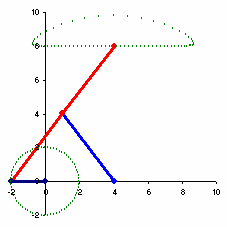Timing Diagram (Part 2 - Maximum acceleration calculation)
Let's calculate the acceleration of the die from previous post [Timing Diagram (Part 1 - No Overlap Movement)]
The die moves using Cycloid cam profile. So first we have to get the formula to calculate the maximum acceleration of cycloid cam profile.
If the machine speed is N (pcs/h) and the indexing angle (degree) is Bm, the indexing time (second) tm can be calculated as follows.
Cycle time (sec) = 3600/N
Indexing time tm (sec) = (Bm/360) x Cycle time = (Bm/360) x (3600/N)
Hence,
Cycloid cam profile has the equation of displacement as follows.
where:
hm: Maximum displacement (m)
tm: Indexing time (s)
pi: 3.141592654
We can get velocity equation by differentiation.
v = dh/dt = hm x [1/tm - (2 x pi)/(2 x pi x tm) x cos(2 x pi x t/tm)]
Then, the acceleration is as follows.
a = d2h/dt2 = dv/dt = hm/tm x [0 - (-2 x pi/tm) x sin(2 x pi x t/tm)]
The maximum acceleration (amplitude) occurs when sin(2 x pi x t/tm) = 1 or -1
Therefore the amplitude of of maximum acceleration is as follows.
We can clearly see from the above derivations that the acceleration is inversely proportional to the square of indexing time. Since the indexing time (tm) is proportional to the indexing angle (Bm), then the maximum acceleration is also inversely proportional to the square of the indexing angle.
That means if we can increase the indexing angle by a factor of two, the maximum acceleration will reduce by a factor of four!!
And we can do this by putting more overlapped motion in the timing diagram design.
From previous post, the die moves 50 mm in 55 degrees using cycloid cam profile.
Let's assume we calculate the maximum acceleration of the die at the machine speed (N) of 2000 pcs/h
So, we have
N = 2000 pcs/h
Bm = 55 deg
hm = 50 mm = 0.05 m
tm = 10Bm/N = 10(55)/2000 = 0.275 s
amax = 2 x pi x hm/tm2 = 2 x 3.141592654 x 0.05 / 0.2752
Let see in the next post when we put more overlap motion, the indexing angle will be increased as well as the indexing time, thus reduce the maximum acceleration.
The die moves using Cycloid cam profile. So first we have to get the formula to calculate the maximum acceleration of cycloid cam profile.
If the machine speed is N (pcs/h) and the indexing angle (degree) is Bm, the indexing time (second) tm can be calculated as follows.
Cycle time (sec) = 3600/N
Indexing time tm (sec) = (Bm/360) x Cycle time = (Bm/360) x (3600/N)
Hence,
Indexing time tm (sec) = 10Bm/N
Cycloid cam profile has the equation of displacement as follows.
h = hm x [t/tm - 1/(2 x pi) x sin(2 x pi x t/tm)]
where:
hm: Maximum displacement (m)
tm: Indexing time (s)
pi: 3.141592654
We can get velocity equation by differentiation.
v = dh/dt = hm x [1/tm - (2 x pi)/(2 x pi x tm) x cos(2 x pi x t/tm)]
v = hm/tm x [1 - cos(2 x pi x t/tm)]
Then, the acceleration is as follows.
a = d2h/dt2 = dv/dt = hm/tm x [0 - (-2 x pi/tm) x sin(2 x pi x t/tm)]
a = 2 x pi x hm/tm2 x sin(2 x pi x t/tm)
The maximum acceleration (amplitude) occurs when sin(2 x pi x t/tm) = 1 or -1
Therefore the amplitude of of maximum acceleration is as follows.
amax = 2 x pi x hm/tm2
We can clearly see from the above derivations that the acceleration is inversely proportional to the square of indexing time. Since the indexing time (tm) is proportional to the indexing angle (Bm), then the maximum acceleration is also inversely proportional to the square of the indexing angle.
That means if we can increase the indexing angle by a factor of two, the maximum acceleration will reduce by a factor of four!!
And we can do this by putting more overlapped motion in the timing diagram design.
From previous post, the die moves 50 mm in 55 degrees using cycloid cam profile.
Let's assume we calculate the maximum acceleration of the die at the machine speed (N) of 2000 pcs/h
So, we have
N = 2000 pcs/h
Bm = 55 deg
hm = 50 mm = 0.05 m
tm = 10Bm/N = 10(55)/2000 = 0.275 s
amax = 2 x pi x hm/tm2 = 2 x 3.141592654 x 0.05 / 0.2752
amax = 4.154 m/s2
Let see in the next post when we put more overlap motion, the indexing angle will be increased as well as the indexing time, thus reduce the maximum acceleration.




Comments